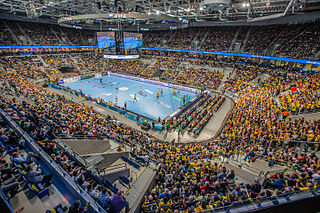
Handball is a team sport in which two teams of seven players each pass a ball using their hands with the aim of throwing it into the goal of the opposing team. A standard match consists of two periods of 30 minutes, and the team that scores more goals wins.

Volleyball is a team sport in which two teams of six players are separated by a net. Each team tries to score points by grounding a ball on the other team's court under organized rules. It has been a part of the official program of the Summer Olympic Games since Tokyo 1964. Beach volleyball was introduced to the program at the Atlanta 1996 Summer Olympics. The adapted version of volleyball at the Summer Paralympic Games is sitting volleyball.

Dodgeball is a team sport in which players on two opposing teams try to throw balls and hit opponents while avoiding being hit themselves. The objective of each team is to eliminate all members of the opposing team by hitting them with thrown balls, catching a ball thrown by an opponent, or inducing an opponent to commit a violation, such as stepping outside the court.
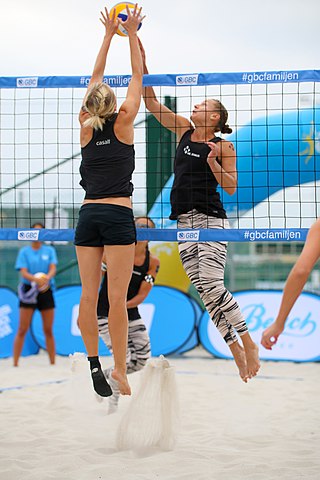
Beach volleyball is a team sport played by two teams of two to four players each on a sand court divided by a net. Similar to indoor volleyball, the objective of the game is to send the ball over the net and to ground it on the opponent's side of the court. Each team also works in unison to prevent the opposing team from grounding the ball on their side of the court.
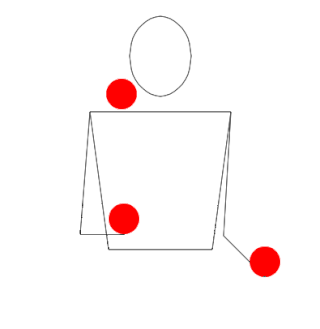
In toss juggling, a cascade is the simplest juggling pattern achievable with an odd number of props. The simplest juggling pattern is the three-ball cascade, This is therefore the first pattern that most jugglers learn. However, although the shower requires more speed and precision, "some people find that the movement comes naturally to them," and it may be the pattern learned first. "Balls or other props follow a horizontal figure-eight [or hourglass figure] pattern above the hands." In siteswap, each throw in a cascade is notated using the number of balls; thus a three ball cascade is "3".
In the cascade, an object is always thrown from a position near the body's midline in an arc passing underneath the preceding throw and toward the other side of the body, where it is caught and transported again toward the body's midline for the next throw. As a result, the balls travel along the figure-eight path that is characteristic of the cascade.

Siteswap, also called quantum juggling or the Cambridge notation, is a numeric juggling notation used to describe or represent juggling patterns. The term may also be used to describe siteswap patterns, possible patterns transcribed using siteswap. Throws are represented by non-negative integers that specify the number of beats in the future when the object is thrown again: "The idea behind siteswap is to keep track of the order that balls are thrown and caught, and only that." It is an invaluable tool in determining which combinations of throws yield valid juggling patterns for a given number of objects, and has led to previously unknown patterns. However, it does not describe body movements such as behind-the-back and under-the-leg. Siteswap assumes that "throws happen on beats that are equally spaced in time."

Passing is the act of juggling between two or more people. It is most commonly seen as a subset of toss juggling.
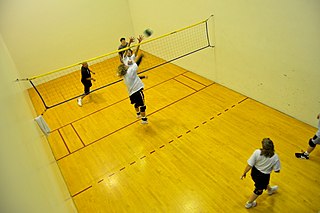
Wallyball is a fast-paced sport that is similar to volleyball played in a racquetball court, where it is legal to hit the ball off of the walls.
Juggling practice has developed a wide range of patterns and forms which involve different types of manipulation, different props, numbers of props, and numbers of jugglers. The forms of juggling shown here are practiced by amateur, non-performing, hobby jugglers as well as by professional jugglers. The variations of juggling shown here are extensive but not exhaustive as juggling practice develops and creates new patterns on a regular basis. Jugglers do not consciously isolate their juggling into one of the categories shown; instead most jugglers will practice two or more forms, combining the varieties of juggling practice. Some forms are commonly mixed, for example: numbers and patterns with balls; while others are rarely mixed, for example: contact numbers passing. Many Western jugglers also practice other forms of object manipulation, such as diabolo, devil sticks, cigar box manipulation, fire-spinning, contact juggling, hat manipulation, poi, staff-spinning, balancing tricks, bar flair and general circus skills.

Juggling world records comprise the best performances in the fields of endurance and numbers juggling.
Hoover ball is a medicine ball game invented by President Herbert Hoover's personal physician, Medal of Honor recipient Joel T. Boone, to help keep then-President Hoover fit. The Hoover Presidential Library Association and the city of West Branch, Iowa co-host a national championship each year.

Fistball is a sport of European origin, primarily played in the German-speaking nations of Austria, Germany and Switzerland, as well as in Brazil. The objective of the game is similar to volleyball, in that teams try to hit a ball over a net, but the rules vary from volleyball in several major ways. The current men's fistball World Champions are Germany, winners of both the 2023 Men's World Championships and the fistball category at the 2022 World Games, while the current women's fistball World Champions are also Germany, after winning the 2021 Women's World Championships.
This is a list of the more common English volleyball jargon terms:
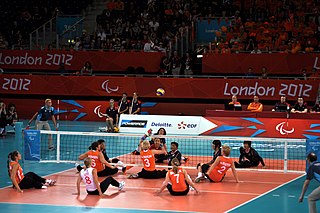
Sitting volleyball is a form of volleyball for athletes with a disability organized by World ParaVolley. As opposed to standing volleyball, sitting volleyball players must sit on the floor to play.
Several sports related to volleyball have become popular. Indoor volleyball and beach volleyball are both events at the Olympics, and sitting volleyball is an event at the Paralympics. Other varieties are localized, or are played at an amateur or informal level.

Newcomb ball (also known simply as Newcomb+, and sometimes spelled Newcombe (ball)) is a ball game played in a gymnasium or court using two opposing teams and a net. Newcomb ball and the sport of volleyball were both created in 1895 and are similar in their design. The sport rivaled volleyball in popularity and participation by the 1920s. The sport of throwball may be a possible relative.

Juggling rings, or simply "rings", are a popular prop used by jugglers, usually in sets of three or more, or in combination with other props such as balls or clubs. The rings used by jugglers are typically about 30 centimetres (12 in) in diameter and 3 millimetres (0.12 in) thick.
Volleyball drills are specialized exercises that enhance teams and players volleyball skills. There are numerous volleyball drills that teams and players can utilize in order to improve and further develop their skills in all areas of the game such as passing, serving, attacking, setting, blocking, and digging. From beginners to well-seasoned players, drills can help all players gain repetitions in various skills and positions; the more repetitions, the better a player can become.
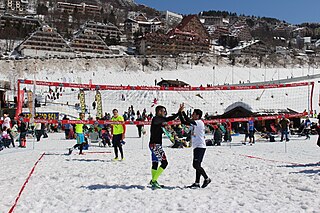
Snow volleyball is a winter team sport played by two teams of three players on a snow court divided by a net. The objective of each team is to score points by sending a ball over the net so as to ground it on the opponent's court, and to prevent the same effort by the opponent. A team is allowed up to three touches to return the ball across the net, and individual players may not touch the ball twice consecutively.













